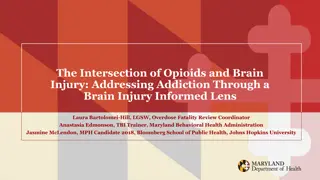Understanding and Supporting Individuals with Self-Injury Behaviors
Exploring the complexities of self-injury behaviors, this content delves into definitions, functions, and treatment considerations for individuals who engage in self-harm. It discusses attitudes and challenges clinicians may face when treating clients who self-injure, emphasizing the importance of building a safe and non-judgmental therapeutic relationship. The text highlights assessment strategies, risk factors, protective factors, and the development of safety plans to aid clients during distressing times.
Download Presentation

Please find below an Image/Link to download the presentation.
The content on the website is provided AS IS for your information and personal use only. It may not be sold, licensed, or shared on other websites without obtaining consent from the author. Download presentation by click this link. If you encounter any issues during the download, it is possible that the publisher has removed the file from their server.
E N D
Presentation Transcript
TREATING SELF-INJURY Tracie W. Ferguson, LPC, NCC
DEFINITIONS SUICIDE Deliberate andfatal self-harm with the presence of some intent to die as a result of the behavior (USDHHS, 2009a) SUICIDE ATTEMPTS Self-injurious behavior with the intent to die (Claes et al., 2010) SELF-INJURY Non-suicidal, volitionally self- inflicted harm to the body that is not socially sanctioned (Klonsky, Muehlenkamp, Lewis, & Walsh, 2011) SELF-HARM Parasuicidal behavior, including suicide attempts (Claes & Vandereycken, 2007) Drs. Julia Whisenhunt, Catherine Chang, and Nicole Stargell ACA 2017 San Francisco, CA
WHISENHUNT, CHANG, STARGELL, 2017 FUNCTIONS OF SELF-INJURY #1 Emotion Regulation (Klonsky & Muehlenkamp, 2007; Turner, Chapman, & Layden, 2012) #2 Self Punishment (Klonsky & Muehlenkamp, 2007; Turner et al., 2012) #3 Anti-Suicide (see Klonsky, 2014) #4 Feeling Generation/ Antidissociation (Turner et al., 2012) #5 Interpersonal Influence and Communication (Turner et al., 2012) #6 Sensation Seeking (See Klonsky, 2014)
ATTITUDE AND KNOWLEDGE TOWARDS CLIENTS WHO SELF-INJURE What comes up for you when you think about helping individuals who self-harm??? Questions of competence Fear Confusion Concern for liability Reluctance to treat
The problem isclients who self- injure usually present with multiple treatment issues * Depression * Anxiety * PTSD * History of sexual abuse * Other Symptoms: low frustration tolerance, need for control or need to be perfect, emotional lability, insecure identity
All treatment begins with a safe and non-judgmental relationship INGENERAL Unconditional Positive Regard Warmth Patience Open Communication Non-leading No Guilt-tripping
TREATMENT CONSIDERATIONS Confidentiality Informed consent Duty to protect/mandated reporting Autonomy versus non-maleficence Assessment Risk factors Protective factors Ask all new clients about their history of self-injury Assessment instruments for SI Suicide risk assessments at intake and periodic intervals Harm and Safety Planning Safety Plan versus suicide or self-injury plan Clients can use a safety plan during times of distress
SAFETYPLANNING 1. Identify your triggers. 2. What are things you can do to distract yourself? 3. What can you go do and who can you go with to distract you? 4. People I can ask for help. 5. Professionals or organizations I can contact for help.
THERAPIESTOCONSIDER Cognitive Therapy Behavioral Management Strategies Motivational Interviewing Family Therapy
DIALECTICAL BEHAVIOR THERAPY MARSHA M. LINEHAN, PHD 1. Distress Tolerance Learning how to get through a crisis without making it worse using skills to reduce your suffering (eg. self- soothing, distraction, relaxation, coping statements...)
DIALECTICAL BEHAVIOR THERAPY (DBT) 2. Mindfulness Focusing on the moment without judging it, so that there will be less focus on the painful past or worrying future events. It creates a balance between the emotional and reasonable mind so that you enter "wise mind". Attention is brought to physical sensations, actions, emotions & thoughts in the present moment without judging/criticizing them.
DIALECTICAL BEHAVIOR THERAPY (DBT) 3.Emotion Regulation Helps you recognize what you feel without being overwhelmed by the emotion(s).This helps you cope with reactions in a healthy way. You also learn things like how to decrease the intensity and fear of emotions increase positive emotions, and looking at behavior that leads to emotional outbursts.
DIALECTICAL BEHAVIOR THERAPY (DBT) 4. Interpersonal Effectiveness You learn healthy relationship skills and social skills in areas such as limit setting, listening, expressing your beliefs and needs, problem solving, and how to cope with conflict in effective ways.
TRAUMA-FOCUSED EXPRESSIVE ART THERAPY Trauma Focused Strengths-based framework Understanding of the impact of trauma Emphasizes physical, psychological, and emotional safety Expressive Arts Therapy Using art, storytelling, dance, music, drama, poetry To help with integration of image (memory) and voice (your story) To foster human growth, development, and healing
IMFINE Can nobody see this smile I m faking? See how inside I m constantly shaking? These people claim they know me well yet no one can my see my crumbling shell. I m fine I whisper, my sadness unknown. They leave me to deal with this anguish alone. I ve hidden behind this wall for most of my life. I ve managed so far, I ve dealt with my strife. Watching as slowly my blood pours down and leaks away. It helps to keep my feelings at bay. I pull down my sleeve to cover my hurt, for approaching footsteps, I am alert. I guess my pretense is just all too real. No one has to know of the pain I feel. The real me, l can fool everybody else. Why can t I fool myself.
WHATWILLITLOOKLIKEWHENYOUNO LONGERFEELTHENEEDTOSELF-INJURE?
Expressive Art Activity What is your symbol for hope?
RESOURCES Klonsky, D. & Muehlenkamp, J. (2007). Self-Injury: A research review for the practitioner. Journal of Clinical Psychology, 63, 1045-1056. doi: 10.1002/jclp.20412. Linehan, M. (2015). DBT Skills Training Manual. New York, NY: The Guilford Press. Perjessy, C., Stagell, N. & Whisenhunt, J. (2016). Addressing ethical issues in treating client self- injury. ACA: Counseling Today. Knowledge Share. Whisenhunt, J. & Kress, V. (2013). Non-suicidal self- injury. In ACA (Ed.), ACA: Practice Briefs.
RESOURCES, CONT. https://selfinjury.com/ http://sioutreach.org http://www.selfinjury.bctr.cornell.edu Conterio, K. & Lader, W., & Bloom, J. (1998). Bodily Harm: The breakthrough healing program for self-injurers. New York: Hyperion. Gratz, K.L., & Chapman, A.L. (2009). Freedom from self-harm: Overcoming self-injury with skills from DBT and other treatments. Oakland: New Harbinger























